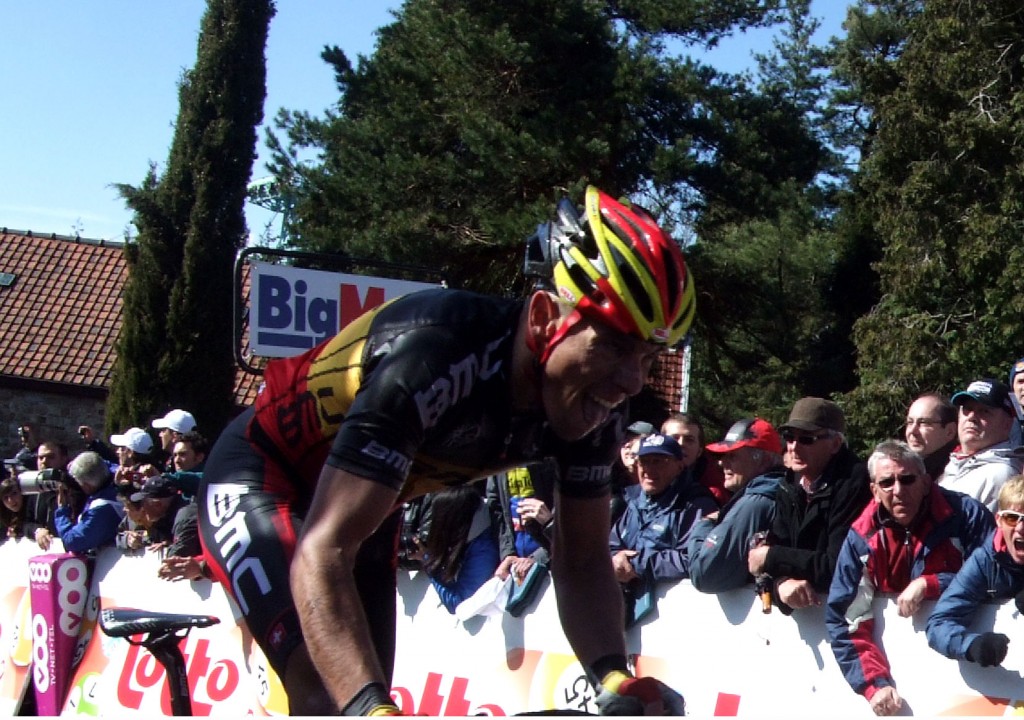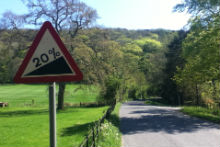It’s market day in Huy, a small Belgian town on the banks of the Meuse, in the Ardennes, west of Liege. Shoppers buying their weekly groceries and go about their business, not intimidated by groups of people visiting their town, walking through the streets, many carrying crates of beer and heading up the hill.

Bars and cafes are full, many have expensive looking bicycles leant against the railings. No-one sits outside, it’s too cold. Blue sky is occasionally obscured by sheets of grey clouds, hurrying by on a strong wind. Attached to the odd lamp post yellow signs sporting black arrows give a clue to why all these visitors are in here. Round the bend and a huge inflatable arc has been erected across the road, from the top hangs a small red plastic triangle: the flamme rouge; one kilometer to go. A marquee beer tent marks the bottom of the climb proper. There’s a bike on a turbo trainer inside. Turn right off the main road, and the hill really ramps up steeply, people are standing around obscuring the town’s name which is written at regular intervals on the road in white paint.
In 1974 the British and Irish Lions rugby team conducted a tour of South Africa. The tour was hugely successful but was also the target of demonstrations and political interference as some thought the tour gave succor to the apartheid regime in the country. Protests continued even during the games, and segregated black South Africans supported the Lions as opposed to the team which only nominally represented them. The country was divided around sport. Now the Rainbow Nation, as South Africa has become known, is united behind the sport, which has become both representative and a multi-cultural obsession.
It could be said that Belgium is a divided state. It is split into two main regions along linguistic lines: the Dutch speaking people of Flanders and the French speakers in Wallonie in the south. There has been talk of partition and the country even holds the record for the longest period without a formal government, a distinction it inherited from post-invasion Iraq. The national elections of June 2010 resulted in majority parties in both regions, but they were unable to agree on terms for the formation of a national government until December 2011. The problems is that Flanders, the northern half of the country, is the main industrial area and the Flemish apparently possess a sense of grievance that it is their productivity which supports the Walloons in the south.
In Belgium cycling is a national obsession, they turn out all year round, and in winter cyclo-cross replaces road racing. As the language differs from north to south, so do the races. Iconic races like the Ronde van Vlaanderen – the Tour of Flanders – routinely climb repeated short, sharp hills, or bergs, interspersed with stretches of windswept flat. The roads are often cobbled, just to add to the suffering. These are races for the hard, powerful men who use their strength to survive and win, not necessarily sprinters, but rouleurs.
Once the cobbled classics of the north are done, cycling’s WorldTour heads south to the low mountains and longer, more sapping climbs of the Ardennes Classics, though with the first of these races, the Amstel Gold Race in the Limburg region of south west Holland, the name is not entirely accurate.
Here the terrain makes for very different, though still attritional, racing. The parcours of all three races is up and down throughout, with each finishing at the top, or immediately after a hard, steep climb. Invariably the winner is the powerful ascender, though not the breed of pure climber who dominates in the high mountains of the Alps or Pyrenées.
Of the Belgian Ardennes Classics, the biggest is Liege-Bastogne-Liege. One of the five Monuments of the sport, it attracts the top racers all hoping to add it to their palmares. I’m here to watch La Fleche Wallonne, the third and the shortest of the three, sandwiched between the other two, perhaps indicating its lesser status on the UCI calendar, even if it is the only one to have a women’s race, on a shortened course, the same day.
As you walk up the hill the crowds deepen, even now, a couple of hours before the riders pass for the first time. Some sit behind the roadside barriers on chairs they have brought, sipping on bottles of Jupiter taken from cold boxes. Others queue at the tents erected every few hundred metres from which beer, hot dogs and burgers are sold. The steepest gradient is about half way up on a tight S bend; overlooking it is a large mound, providing a perfect viewing point. There is another beer tent crammed between the trees by the verge, the group gathered here all holding what is unlikely to be the first beer of the day, judging by the festival atmosphere. At each of those tents the scene is repeated. After the bend the gradient relents slightly before again kicking up, a formidable challenge for the many amateur cyclists who weave their way through the throng.
At the top every space is taken, with the race administration and press boxes on one side, bars and stands selling frites and sausages on the other. The aroma of frying potatoes hangs in the air over the hundreds of people here already drinking beer, there’s even a group stood at the back of a Team Rabobank minibus cracking open bottles of Jupiter. This is a social occasion in Belgium, and it seems beer is an essential part of the day for most people.
But not the riders. Beyond the finish area and almost casually, police officers blow their whistles, imploring us to clear the road. A few motorbikes fly past then two riders come through. Obviously the breakaway, they have some minutes on the main group who, as casually as the police cleared us, rush through in a very large group, few showing the strain of the hill they have just climbed.
As with so many of the older races, La Fleche Wallonne was started in 1936 to publicise a local newspaper. A bit of a nomad, it seemed to take a while to find its home, wandering around the hills between Charleroi and Liege. In 1984 it settled down a bit and established it’s finish at the top of the Mur de Huy – the Wall. This vicious climb, its steepest sections over 20 per cent, is climbed twice by the men and once by the women, before the riders slog their way up for the final time. This is great for the spectator.
The crowd is three or four deep now, viewing space at a premium, there’s beer soaked breath, and red cockerels stand proud on yellow Walloon flags, fluttering together with those emblazoned with the names of fans’ favourite riders. The women’s race passes us, spread far and wide, though the favourites are all together at the front. The next time we see them they are really strung out, and Evelyn Stevens powered past four-time winner, and out-and-out favourite, Marianne Vos, to take the win.
The pace of activity is speeding up now and the police officers keep clearing the road with frustrating regularity. The caravan emerges up the slope sending late middle-aged men in an undignified rush to grab and grovel on the ground to retrieve the coloured pens and flimsy hats thrown by the hundred as a memento.
The men are back now and much more spread out. Rain has spattered man and machine with mud, though the sun is now shining. The noise of the crowd is huge, they bang the boards and shout loudly, “Philippe, Philippe, allez Gilbert!” as, near the front of the main peloton, the Belgian national champion rides past in company with all the other favourites for the day. Obviously battle weary they manage to look alert and are almost inconceivably fast, considering what they have just ascended. The group is now spread down the hill, the stragglers escorting the convoy of support vehicles with the smell of burning clutches adding to that of frites and beer in their nose.
The voice of the race commentator is more excited now, I can understand few of the words but more of the names, mainly local hero Philippe Gilbert, who won this race and the other two Ardennes Classics last year. Flandrian Jelle Vanendert gets a few mentions, too. It rains hard, sending some scurrying for cover, though not too far away, for fear of losing their place by the barriers, which were packed earlier. French is the local language, though there were as many Dutch or Flemish voices near by.
I can see a helicopter hovering over the valley. There are two more high above us. The murmuring of the crowd crackling with excitement. The TV cameraman opposite me steps on his cigarette, having finished his beer a little earlier, then points his camera down the hill. The rumble of banged advertising boards ripples up the slope with the roar of the excited crowd, both heralding the arrival of the first rider. Gilbert? Vanendert? The only names I’ve heard. Joaquin Rodriguez sails past. The grimace on his face thick with grime. The noise of the crowd deafening and silent at once. We are part of the spectacle, we can feel the suffering, the tearing agony in his legs, understand the fear of being overtaken as he labours in slow motion towards victory. Seconds later, in a world of pain is Michael Albasini then, reward for the waiting crowd as Gilbert leads Vanendert past us, Walloon leads Flandrian. The roaring crowd don’t care, they’re Belgian.
It was fitting they came in together, the two top Belgians. It’s not been the 2012 Gilbert would have hoped for, but Flandrian and Walloon alike have had Boonen to win for them in the cobbled Classics. Equally, while Boonen was crashing and puncturing his way through a dismal campaign in 2011, the whole country cheered the all-conquering Gilbert. Belgium is united in cycling, it’s in their blood and their passion infects you standing among them at the road side.





